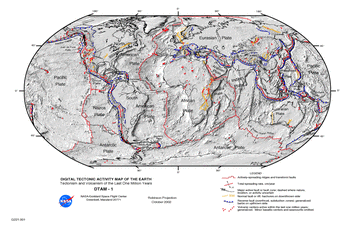Things for Unit 6 you should UNDERSTAND, KNOW, and be able to DO...
Understand:
- The Theory of Plate Tectonics is supported by a growing body of evidence.
- The geography, climate and organic evolution of Earth has gone through- and continues to go through - a constant state of change.
- How has the collection of ongoing evidence changed our views of crustal activity?
Know:
- Properties of Earth’s internal structure (crust, mantle, inner core, and outer sore) can be inferred from the analysis of the behavior of seismic waves (including velocity and refraction)
- The more dense and rigid a material is, the greater the velocity of the seismic waves.
- P-waves will pass through solids, liquids and gases.
- S-waves will only pass through solids. S-waves do not pass through the outer core of the Earth; therefore, the outer core is liquid.
- Evidence leads to the inference that Earth’s interior is composed of layers that differ in composition and states of matter.
- Analysis of seismic waves allows the determination of the location of earthquake epicenters, and the measurement of earthquake magnitude.
- P-waves travel faster than all other types of seismic waves. S-waves are the second fastest.
- The farther an observer is from an epicenter, the larger the time interval between the P-waves and S-waves.
- To find the position of the epicenter, at least three seismograph locations must be used.
- The lithosphere consists of separate plates that ride on the more fluid asthenosphere. These plates move slowly in relationship to each other, indicating Earth is a dynamic geologic system.
- Earth’s systems have internal sources of energy which creates heat and regions of density differences. These differences result in motion.
- There are three types of plate boundaries (divergent, transform, convergent) each resulting in different geologic activity and landforms.
- Regions located close to plate boundaries are more likely to experience tectonic activity
- The continental crust is thicker, less dense compared to the oceanic crust which is thinner, denser.
- New ocean crust continues to form at mid-ocean ridges.
- Earthquakes and volcanoes present geologic hazards to humans which can be reduced through emergency preparedness.
- Many of the Earth’s surface features (mid-ocean ridges, trenches, mountain ranges, subduction zones, hot spots, magnetic and age patterns are consequences of forces associated with plate motion and interactions.
- Many processes of the rock cycle are consequences of plate dynamics.
- The production of magma occurs at both subduction and rifting regions.
- Regional metamorphism occurs within subduction zones.
- The creation of major depositional basins occurs through down-warping of the crust.
- Landforms are the result of the interaction of tectonic forces and the processes of weathering, erosion, and deposition.
Vocab Terms: Asthenosphere, continental drift, convection, convergent boundary, crust, p-wave, s-wave, divergent boundary, earthquake, epicenter, fault, focus, hotspot, lithosphere, magnitude, mantle, mid-ocean ridge, origin time, Pangea, plate boundary, plate tectonics, Richter scale, sea-floor spreading, seismic station, seismograph, subduction zone, transform boundary, trench, shadow zone, refraction, geologic activity, landform, inner core, outer core, Ring of Fire
Extended Vocabulary: tsunami, magnetic reversal, Moho, volcano, hydrothermal vents
Do:
- Compare and contrast the characteristics of P and S-waves.
- Analyze P and S-wave arrival times from three seismic stations to locate the epicenter of an earthquake using ESRT page 11.
- Determine the distance from an epicenter by using P and S-wave arrival times and ESRT page 11.
- Describe inferred properties of Earth’s interior using earthquake time/travel data (shadow zones).
- Explain measurement of earthquake energy (Richter Scale and Mercalli Scale).
- Describe the features and locations of plate boundaries.
- Identify the direct and indirect evidence of crustal movement.
- Describe the evidence of continental drift.
- Explain how heat and density result in the movement of crustal plates.
- Use page 5 of the ESRT to determine the relative motion at plate boundaries.
- Use Inferred Properties of Earth’s Interior (page 10 ESRT) to determine how temperature, pressure, and density change with depth.


